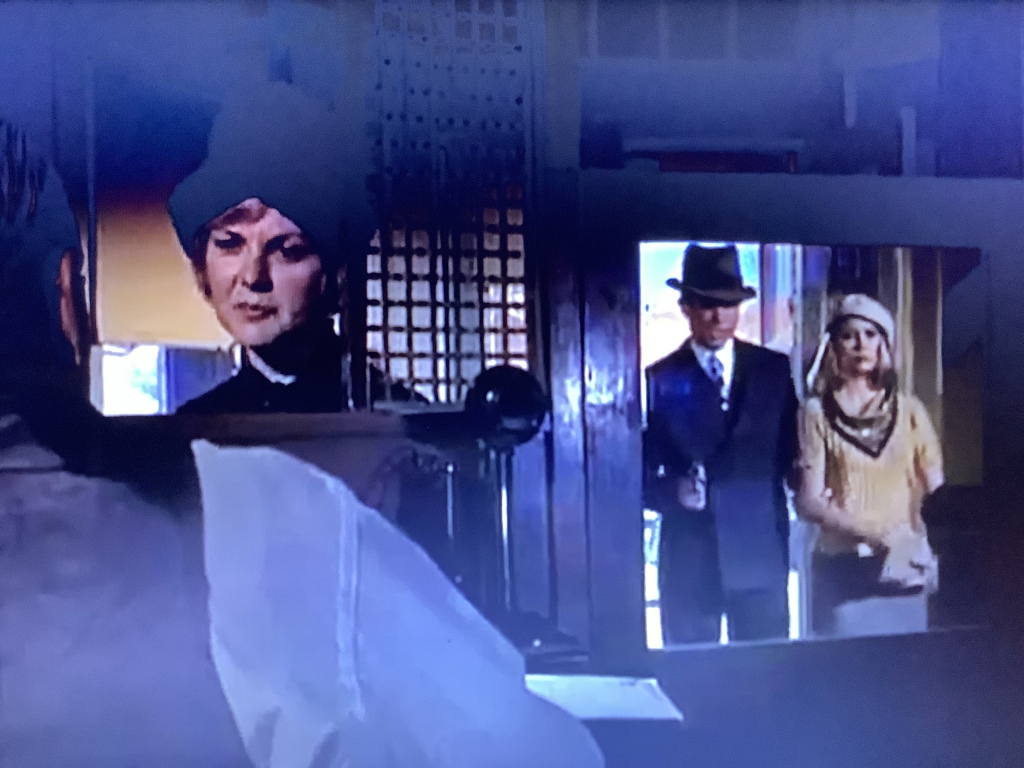Overview
The “botched heist” sequence of Bonnie and Clyde (Arthur Penn, 1967) proves that not everything the gang attempts will go to plan, serving to highlight the gritty realism presented over the course of the film. The scene displays the titular couple attempting to rob a town bank, which seems to be going to plan until their attempted escape. The gang’s newly appointed getaway driver, C.W. Moss, inadvertently hinders the heist by parking the car away from the bank. Moss then struggles to pull away, accidentally hitting two cars. As the gang finally manages to drive away, a man jumps onto the car – prompting Clyde to shoot him in the face.
Key Elements, Context, and Representation
The sequence opens with an extreme long shot taken from under the awning of an establishment, serving to immerse the viewer in the evocative rural Southern town. This shot is deliberately framed as to draw the viewer’s attention towards the crossroads at the centre of the town, naturally guiding our focus towards the bank. The bank itself is highly decrepit and derelict, perhaps being indicative of the negative effects suffered by these small establishments after the Great Depression. Each extra that appears in the scene are real townsfolk, preserving to the authenticity of the scene.
As we cut to the bank itself, we are presented with an appropriately desolate setting – the use of a wooden brown further establishes the bank as part of the rural Southern community. Clyde wears a navy blue suit, juxtaposing Bonnie’s crème-coloured clothes – perhaps symbolising Clyde’s history with robbery and crime. Bonnie also interestingly dons a beret, an evocative piece of French fashion that subtly paying homage to the French New Wave, a movement that highly influenced the film’s production. The couple are also framed within a frame as they enter the bank, drawing further audience focus to them.

The dialogue and movements within the bank appear to be largely improvised, indicative of the film’s attempts to strive for reality. As Bonnie and Clyde holds up the bank, the soundscape is fully diegetic, which creates a naturalistic atmosphere. This scene is edited in parallel with C.W. Moss outside, attempting to park the car away from the bank. These shots are edited in a much more conventional sequence, being reminiscent of the Classical Hollywood style.
During the getaway itself, the diegetic sound of the alarm bell promptly enters the mix which immediately heightens the tension. The pace of editing also quickens, rapidly cutting between closeups of Clyde pointing his gun at the window with closeups of the man latched onto the car behind the window. As Clyde shoots the man in the mouth, we cut to a centrally-framed closeup in which a shockingly graphic amount of blood is displayed. This gratuitous display of violence breached the boundaries of what was allowed within cinema for the time, through which Bonnie and Clyde later garnered a notorious reputation for. After witnessing the couple’s distraught reactions, we cut to another closeup that showcases the man’s face sliding down the window. This repulsive display of violence instils a sense of uneasy discomfort within the viewer – the audience is forced to confront and later contemplate Clyde’s violent actions.
This sequence interestingly mirrors the earlier scene of Clyde robbing the grocery store in the opening sequence, yet the absence of a jaunty Bluegrass score strips the sequence of its prior light-hearted mood. The viewer is now fully confronted with the gritty reality of Bonnie and Clyde’s actions, enhancing the film’s endeavour to strive for naturalistic authenticity.